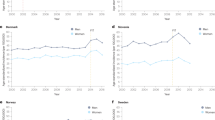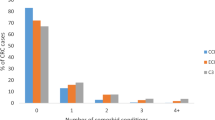Abstract
In two case–control studies from Italy covering 3533 cases of colorectal cancer and 7062 hospital controls, the odds ratios were 1.04 after cholecystectomy for colorectal, 1.08 for colon and 1.03 for rectal cancers. The results did not differ significantly by gender, colon subsite or time since diagnosis.
Similar content being viewed by others
Main
At least four large record linkage and cohort studies (Ekbom et al, 1993; Goldbohm et al, 1993; Johansen et al, 1996; Lagergren et al, 2001) and two meta-analyses (Giovannucci et al, 1993; Reid et al, 1996) found some increase of colorectal cancer risk following cholecystectomy. No association was found in another population-based cohort study from Sweden, including 150 colorectal cancer cases (Adami et al, 1987). The strength of the association, generally modest but significant in several studies (Ekbom et al, 1993; Giovannucci et al, 1993; Reid et al, 1996; Lagergren et al, 2001), has varied across different studies, colorectal subsites and sex (being somewhat stronger for proximal colon and for women). However different potential confounding factors and time since cholecystectomy have not always adequately been taken into account. Overweight and obesity are relevant risk factors for both gall bladder (Lew and Garfinkel, 1979; La Vecchia et al, 1991) and colorectal cancer (Lew and Garfinkel, 1979; Russo et al, 1998; Terry et al, 2001; Adami and Trichopoulos, 2003; Calle et al, 2003), and may therefore represent both an underlying pathogenetic mechanism and a potential confounding factor.
In the Nurses' Health Study, including 877 women diagnosed with colorectal cancer, an increased relative risk (RR) of 1.21 (95% confidence interval (CI) 1.01–1.46) was found in relation to history of gallstones or cholecystectomy (reported by 133 colorectal cancer cases), after adjusting for potential confounding factors (Schernhammer et al, 2003). The highest risks were reported for proximal colon (RR 1.34, 95% CI 0.97–1.88) and rectum cancer (RR 1.58, 95% CI 1.05–2.36).
We have examined the relation between gallstones and colorectal cancer risk using data derived from two large Italian case–control studies on colorectal cancer, taking advantage of information on body size and of a comprehensive food-consumption questionnaire.
Materials and methods
The first study was conducted between 1985 and 1991 in the greater Milan area (La Vecchia et al, 1988; Ferraroni et al, 1994), and the second one between 1991 and 1996 in six Italian areas: Greater Milan, the province of Pordenone, the urban area of Genoa and the province of Forlì, in northern Italy; the province of Latina, in central Italy; and the urban area of Naples, in southern Italy (La Vecchia et al, 1997). Overall, there were 3533 patients, aged 19–79 years (median age 62) with incident (i.e. diagnosed within the year before interview), histologically confirmed cancer of the colon (2180 cases) or rectum (1353 cases), from the major teaching and general hospitals in areas under surveillance. Cancers of the colon and rectum and their anatomical subsites were defined according to the International Classification of Diseases, Ninth Edition (ICD-9). Colon cancer corresponded to ICD-9 153; ascending colon included ICD-9 153.0, 153.4, 153.5 and 153.6; transverse and descending colon ICD-9 153.1, 153.2 and 153.7; sigmoid colon corresponded to ICD-9 153.3. Rectosigmoid junction corresponded to ICD-9 154.0 and rectum to ICD-9 154.1.
Controls were 7062 patients, aged 19–79 years (median age 57), residing in the same geographical areas and from the same network of hospitals where cases had been identified, and admitted for a wide spectrum of acute, non-neoplastic conditions, unrelated to known or potential risk factors for colorectal cancer (30% traumas, mostly fractures and sprains; 25% nontraumatic orthopaedic conditions, mostly low back pain and disk disorders; 21% acute surgical diseases, mostly abdominal, such as acute appendicitis or strangulated hernia, and 24% other miscellaneous disorders, such as eye, ear, nose and throat and dental disorders). Less than 4% of cases and controls approached refused to participate. Information was collected in hospital by trained interviewers using a structured food-frequency questionnaire, tested for reproducibility and validity (Decarli et al, 1996). The patients were asked if they had a diagnosis of selected medical conditions, and the age at first diagnosis was recorded.
Odds ratios (OR) and corresponding 95% CIs were estimated using unconditional multiple logistic regression models, including terms for age (<35, 35–39, 40–44, 45–49, 50–54, 55–59, 60–64, 65–69, 70–74, ⩾75 years), sex, study centre, years of education (<7, 7–10, >10 years), cigarette smoking (never smokers, ex-smokers, smokers of <15, 15–24, ⩾25 cigarettes/day), alcohol drinking and meat consumption (tertiles of consumption), body mass index (BMI, kg/m2) and total energy intake (tertiles), history of diabetes, history of colorectal cancer in parents and siblings, menopausal status (pre-, postmenopause), use of oral contraceptives or hormone replacement therapy (ever, never use).
Results
Table 1 shows the distribution of colorectal cancer cases and controls, and the corresponding ORs, according to history and time since diagnosis of cholelithiasis. Subjects with a history of cholelithiasis showed no appreciable increased risk of colorectal cancer (OR 1.04, 95% CI 0.90–1.21). Similar results were found for colon (OR 1.08, 95% CI 0.91–1.28) and rectal (OR 1.03, 95% CI 0.83–1.27) cancer. The OR was 1.03 (95% CI 0.72–1.47) for proximal colon and 1.17 (95% CI 0.93–1.47) for distal colon cancer. The ORs for men were 1.21 for colorectal, 1.24 for colon and 1.22 for rectal cancer, and for women were 0.95, 1.01 and 0.93 respectively. With reference to time since cholelithiasis, ORs for less than 10 years were 1.13 for colorectal, 1.16 for colon and 1.12 for rectal cancer; no association was found for 10 or more years before interview.
Discussion
Our findings indicate that cholelithiasis is not materially associated with colorectal cancer risk after adjustment for major identified confounding factors, including measures of BMI, total energy and meat intake. A modest nonsignificant excess risk was found among men and for less than 10 years after cholelithiasis, but no excess risk could be found after 10 or more years. Such a time-risk relation is inconsistent with a causal relation of cholelithiasis with colorectal cancer risk. The risk estimates were not heterogeneous for men and women. However, the finding that several ORs were apparently higher in men is in broad agreement with the observation, in the same data set, that higher BMI is more consistently related to colorectal cancer risk in men than in women (Russo et al, 1998). None of these estimates was significant, suggesting that any association is unlikely to be causal. No material association was observed when the analysis was restricted to proximal colon.
The apparent association reported from some case–control studies may at least in part be due to a more accurate recall of gall bladder disease by colorectal cancer patients and by the inadequate adjustment for other potential risk factors for colorectal cancer, including diet. In our study, based on a notably large data set, information on medical history was satisfactorily reproducible (Bosetti et al, 2001), indicating that recall bias is unlikely to have played a major role. Other potential biases of this study should be limited, given the almost complete response rate, the similar catchment area for cases and controls and the administration of a standard questionnaire under similar conditions.
Change history
16 November 2011
This paper was modified 12 months after initial publication to switch to Creative Commons licence terms, as noted at publication
References
Adami HO, Krusemo UB, Meirik O (1987) Unaltered risk of colorectal cancer within 14–17 years of cholecystectomy: updating of a population-based cohort study. Br J Surg 74: 675–678
Adami HO, Trichopoulos D (2003) Obesity and mortality from cancer. N Engl J Med 348: 1623–1624
Bosetti C, Tavani A, Negri E, Trichopoulos D, La Vecchia C (2001) Reliability of data on medical conditions, menstrual and reproductive history provided by hospital controls. J Clin Epidemiol 54: 902–906
Calle EE, Rodriguez C, Walker-Thurmond K, Thun MJ (2003) Overweight, obesity, and mortality from cancer in a prospectively studied cohort of U.S. adults. N Engl J Med 348: 1625–1638
Decarli A, Franceschi S, Ferraroni M, Gnagnarella P, Parpinel MT, La Vecchia C, Negri E, Salvini S, Falcini F, Giacosa A (1996) Validation of a food-frequency questionnaire to assess dietary intakes in cancer studies in Italy. Results for specific nutrients. Ann Epidemiol 6: 110–118
Ekbom A, Yuen J, Adami HO, McLaughlin JK, Chow WH, Persson I, Fraumeni Jr JF (1993) Cholecystectomy and colorectal cancer. Gastroenterology 105: 142–147
Ferraroni M, La Vecchia C, D'Avanzo B, Negri E, Franceschi S, Decarli A (1994) Selected micronutrient intake and the risk of colorectal cancer. Br J Cancer 70: 1150–1155
Giovannucci E, Colditz GA, Stampfer MJ (1993) A meta-analysis of cholecystectomy and risk of colorectal cancer. Gastroenterology 105: 130–141
Goldbohm RA, van den Brandt PA, van't Veer P, Dorant E, Sturmans F, Hermus RJ (1993) Cholecystectomy and colorectal cancer: evidence from a cohort study on diet and cancer. Int J Cancer 53: 735–739
Johansen C, Chow WH, Jorgensen T, Mellemkjaer L, Engholm G, Olsen JH (1996) Risk of colorectal cancer and other cancers in patients with gall stones. Gut 39: 439–443
Lagergren J, Ye W, Ekbom A (2001) Intestinal cancer after cholecystectomy: is bile involved in carcinogenesis? Gastroenterology 121: 542–547
La Vecchia C, Braga C, Negri E, Franceschi S, Russo A, Conti E, Falcini F, Giacosa A, Montella M, Decarli A (1997) Intake of selected micronutrients and risk of colorectal cancer. Int J Cancer 73: 525–530
La Vecchia C, Negri E, D'Avanzo B, Franceschi S, Boyle P (1991) Risk factors for gallstone disease requiring surgery. Int J Epidemiol 20: 209–215
La Vecchia C, Negri E, Decarli A, D'Avanzo B, Gallotti L, Gentile A, Franceschi S (1988) A case–control study of diet and colorectal cancer in northern Italy. Int J Cancer 41: 492–498
Lew EA, Garfinkel L (1979) Variations in mortality by weight among 750 000 men and women. J Chronic Dis 32: 563–576
Reid FD, Mercer PM, Harrison M, Bates T (1996) Cholecystectomy as a risk factor for colorectal cancer: a meta-analysis. Scand J Gastroenterol 31: 160–169
Russo A, Franceschi S, La Vecchia C, Dal Maso L, Montella M, Conti E, Giacosa A, Falcini F, Negri E (1998) Body size and colorectal-cancer risk. Int J Cancer 78: 161–165
Schernhammer ES, Leitzmann MF, Michaud DS, Speizer FE, Giovannucci E, Colditz GA, Fuchs CS (2003) Cholecystectomy and the risk for developing colorectal cancer and distal colorectal adenomas. Br J Cancer 88: 79–83
Terry P, Giovannucci E, Bergkvist L, Holmberg L, Wolk A (2001) Body weight and colorectal cancer risk in a cohort of Swedish women: relation varies by age and cancer site. Br J Cancer 85: 346–349
Acknowledgements
This work was conducted with the contribution of the Italian Association for Cancer Research, the Italian League Against Cancer and the Italian Ministry of Research (COFIN 2003). We thank Ms MP Bonifacino for editorial assistance.
Author information
Authors and Affiliations
Corresponding author
Rights and permissions
From twelve months after its original publication, this work is licensed under the Creative Commons Attribution-NonCommercial-Share Alike 3.0 Unported License. To view a copy of this license, visit http://creativecommons.org/licenses/by-nc-sa/3.0/
About this article
Cite this article
Altieri, A., Pelucchi, C., Talamini, R. et al. Cholecystectomy and the risk of colorectal cancer in Italy. Br J Cancer 90, 1753–1755 (2004). https://doi.org/10.1038/sj.bjc.6601721
Received:
Revised:
Accepted:
Published:
Issue Date:
DOI: https://doi.org/10.1038/sj.bjc.6601721
Keywords
This article is cited by
-
Gallstones and the Risk of Gallbladder Cancer Mortality: A Cohort Study
American Journal of Gastroenterology (2016)
-
Cancer risk in patients with cholelithiasis and after cholecystectomy: a nationwide cohort study
Journal of Gastroenterology (2014)



